The Kabbalah, the Tarot and the Middle Way
Kenneth Chan
11. Journey to the Limitless
When Chokmah (in Assiyah) has been sufficiently primed by the three paths leading to it from Chesed, Tiphareth, and now also from the revealed Daath, we will be ready for the path that leads to Kether. Chokmah is now described by the Yetziratic text as follows:
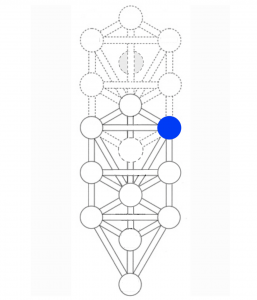
CHOKMAH – WISDOM
“The Second Path is called the Illuminating Intelligence. It is the Crown of Creation, the Splendour of Unity, equaling it. It is exalted above every head, and is named by Kabbalists, the Second Glory.”
Spiritual Experience: The Vision of God face to face.
After it has been transformed by the mystical experience of the revealed Daath, Chokmah can be rightly called the “Illuminating Intelligence” for this aspirational aspect of our being now carries the inspirational flame that can light the way for us to strive forward in our spiritual quest. It is called “the Crown of Creation, the Splendour of Unity, equalling it” because the path to Kether has now been opened. It is the “Second Glory” because it can now be linked directly to the “Primal Glory” which is Kether.
There are many clues for this important path from Chokmah to Kether, since it is described by the Yetziratic text, as well as being depicted by both a Hebrew letter and a Tarot card, and it is also one of the paths in the Noble Eightfold Path centered around Tiphareth of the World of Yetzirah.
The path from Chokmah to Kether is described by the Yetziratic text as follows:
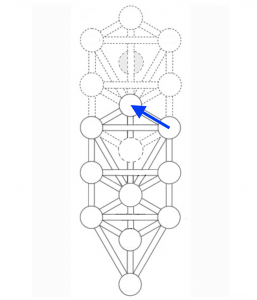
The 11th Path: Chokmah – Kether
“The Eleventh Path is the Scintillating Intelligence because it is the essence of the Veil which is ordered in the arrangement of the system, and this is a special dignity given to it that it may be able to stand before the Face of the Cause of Causes.”
Hebrew Letter: Aleph. Ox.
Tarot Card: Death
Noble Eightfold Path: Right Action
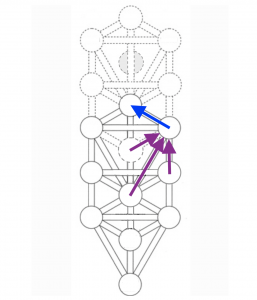 This is the path that Chokmah now initiates after the Sephirah has been primed by three paths—that from Chesed, Tiphareth, and the revealed Daath. The path from Chesed provides the understanding that all things are empty of inherent existence, the path from Tiphareth provides the intention to live in accordance with this principle of emptiness, and the path from Daath provides a direct experience of this state of emptiness and a loss of the sense of self, coupled with a sense of the transcendent “One” as Plotinus understands it.
This is the path that Chokmah now initiates after the Sephirah has been primed by three paths—that from Chesed, Tiphareth, and the revealed Daath. The path from Chesed provides the understanding that all things are empty of inherent existence, the path from Tiphareth provides the intention to live in accordance with this principle of emptiness, and the path from Daath provides a direct experience of this state of emptiness and a loss of the sense of self, coupled with a sense of the transcendent “One” as Plotinus understands it.
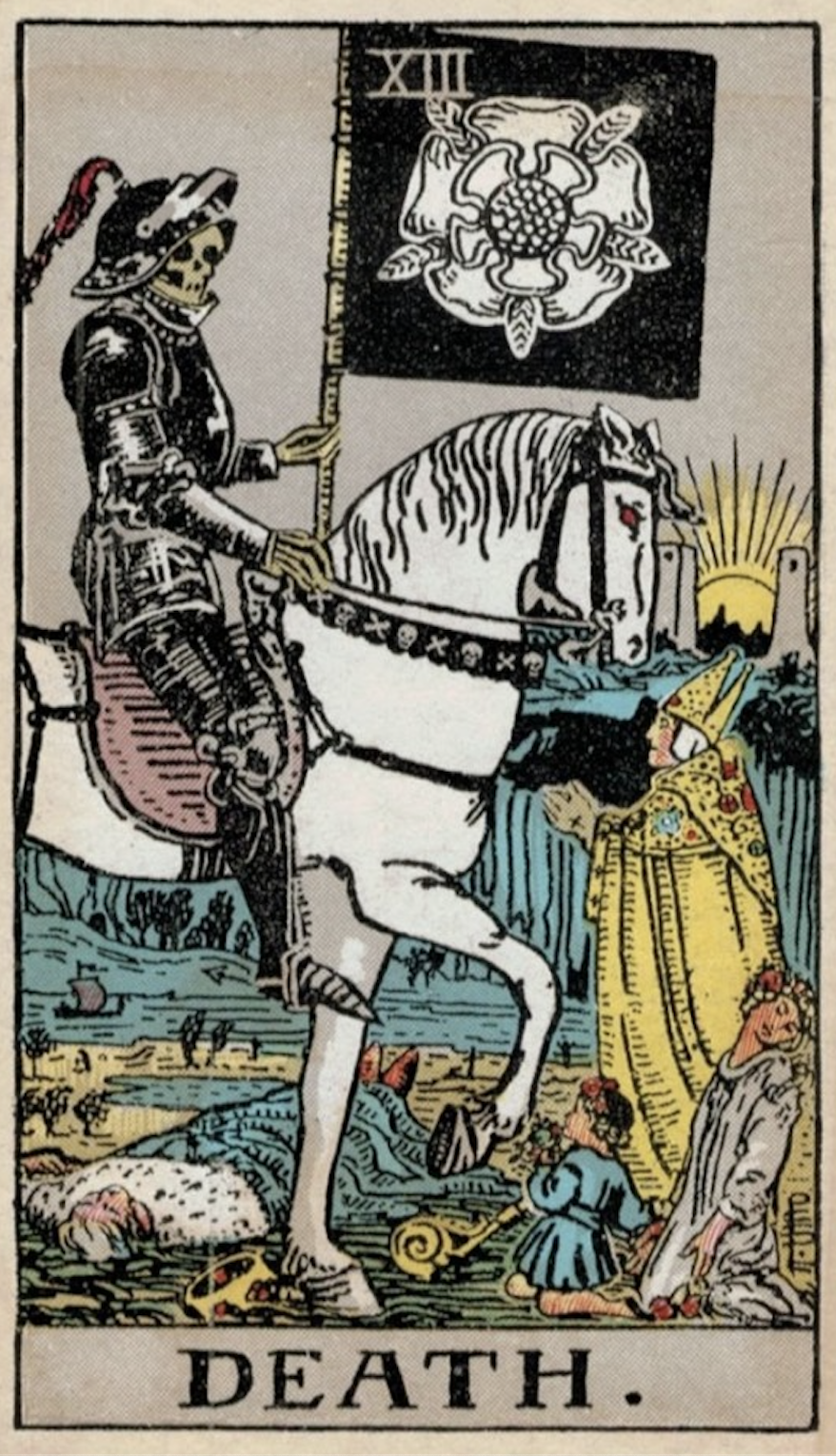
With all these influences, Chokmah, the aspirational aspect of our being, will naturally perform one action, which is depicted by this path designated, by the Noble Eightfold Path as that of Right Action. And that is to act in accordance with this realization of the loss of the sense of self. It is depicted by the Tarot card, Death. It represents the death of the “I” which we have, until now, nurtured in our life as though it were the most important thing in the world. The Tarot card appropriately depicts a fallen monarch which represents this ruler of our mind, a mind that formerly focused on and doted upon this image of the self practically without respite.
The mysterious horseman bears a black banner emblazoned with the Mystic Rose, which actually signifies life. And it is a new life, free from the shackles of having to serve this overpowering sense of the “I.” In the distance, we see the rising sun brilliantly lighting the way between the two pillars signifying the ascent of our spirit towards a more profound state of nonduality.
In a similar way to how the path of renunciation of our self-interests (from Geburah to Binah) leaves a vacuum in our motivation, this loss of the sense of self leaves an even more profound one. There is no longer the “I” to focus our motivation in life, and this vacuum has to be filled with a different motivation. After the mystical experience of the transcendent “One” and the unity of the All, the natural replacement in our motivation would be to work for the benefit of all beings without any consideration of how this affects our image of the self, since we have been freed from this ruler of our mind. This then is the path of Right Action.
The Hebrew letter “ox” has been assigned to this path because, among the Four Creatures of Ezekiel, ox represents the domesticated animals. Here, it signifies the taming of the wild beast which is our deluded clinging to the image of the self, the “I” that we have been incessantly nurturing up till this time.
The other path that leads directly to Kether comes from the revealed Daath, and this path is represented by the Tarot card, Temperance. It is also designated, by the Noble Eigthfold Path, as the path of Right Livelihood.
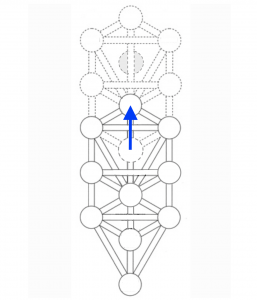
YETZIRAH: Yesod – Tiphareth
Tarot Card: Temperance
Noble Eightfold Path: Right Livelihood
It is the path that aims to infuse the mystical experience of Daath onto our more sustainable realizational state of mind represented by Tiphareth. In other words, it is to make the realizations arising from the mystical direct experience of the higher spiritual state become a feature of the realizational state of mind when we are not having a mystical experience.

This then is the path of Right Livelihood, which means that we now have to strive to live our daily lives in accordance with the realizations arising from the mystical experience at Daath. We have to strive to cease behaving or thinking in ways that contradict those realizations, and it is a difficult task. It is appropriately depicted by the Tarot card, Temperance, because it is essentially a path of abstinence. It is abstinence from reverting to our former state of mind that holds the sense of the “I” as the most important thing in life.
The angel is in the act of generating the mind of nonduality, represented by her action of joining the waters between the two cups. She also has one foot in the water and one foot on land. This symbolizing the fact that we have now to function in two worlds, the world when we are in meditation or having a mystical experience, and the world when we are in the post-meditation state, our routine natural state of mind. The aim is to bring the realization of nonduality into our state of mind when we function in the mundane world. In a sense, we are now to strive to make more permanent the state of mind we experienced in Daath. The Tarot card depicts an angel performing this task because it is the inspiration coming from the divine source, as manifested in the mystical experience at Yesod, that is the driving motivation for this path. Nonetheless, considerable effort and perseverance is required to accomplish this task of bringing the experience at Yesod to the more stable state of mind represented by Tiphareth.
It is possible to actually generate and bring about a state of mind akin to that of the mystical experience if we generate the correct conditions. This means that our mind can alternate between these two states—a blissful state, where we have a unitive experience akin to that of the mystical experience, and our mundane state of mind when we are out of mystical state. That is why the Tarot card depicts the angel having her feet in different worlds. And all the time she is trying to infuse the realization of nonduality, represented by her action of joining the waters in the cups.
We can also view this path as the task of bringing about the blissful state of mind (akin to the mystical experience) more and more in our daily lives, to make it last longer and be more frequent, until eventually it becomes our natural state of mind.
How then do we generate this state of mind? The most critical condition is the loss of the sense of self. This is the critical realization that needs to be maintained in all our thinking if we are to generate the blissful state that is akin to the mystical experience. It is also a realization that can be easily lost, sometimes in ways that we would not be aware of. Whenever, we find it impossible to generate this state of mind that we seek, it usually means that the sense of the “I” has somehow crept back into our way of thinking. We then have to conduct a “witch-hunt” to seek out where this erroneous way to thinking has imposed itself again in our thinking and correct it. Often, when this is achieved, the blissful state of mind returns immediately.
As an example, we could suddenly lose this state of mind, while reading a book, and inadvertently assigning a reality of the self to the characters in the book. This is enough to make it impossible to generate the blissful state that we seek to maintain. We may not even be aware of the reason why we can no longer generate this experiential state. We will have to conduct a meticulous witch-hunt to ferret it out. Once we correct this erroneous way to thinking, the blissful state of realization will immediately return. This is the kind of action we have to repeatedly undertake because it is so easy to habitually think in the wrong way.
Two other factors will greatly help in the generation of this state of mind. One is to hold a sense of nonseparation and a sense of the oneness of All in our mind. And the other is generate a mind of compassion for all sentient beings, a mind that feels the suffering of others and hold the wish to help them. These attributes, combined with the loss of the sense of self, becomes a potent force that will enable us to enter into the realms of our inner spiritual being, where we can experience a profound state of bliss and realization akin to the transcendent union with the All.
There are times, however, when we feel like reverting back to our former state of clinging onto the sense of an “I.” This can occur, even though we have experienced a far more blissful state of being when we lose this sense of the self. This is because we can feel uncomfortable being in such a different state of mind, and even feel that we have lost something of ourselves and are sad about it. It can feel like our former selves have somehow been abandoned and have disappeared. At times, this sense of loss can make us feel uncomfortable and unnatural. This is when we really have to put in the effort to abstain from reverting back to our former erroneous way of thinking, and is often one of the hardest tasks we will encounter on this path from Daath to Tiphareth. But we just have to put up with being uncomfortable in this new state of mind until the feeling of discomfort passes. And it will.
Thus, this path, from the revealed Daath to Kether, appropriately depicted by Temperance, is that of finding the Right Livelihood, which is essentially the task of abstaining from reverting to the habit of nurturing the self as though it were a real entity. Its aim is to maintain the balance of keeping to the middle way between the two extremes of existence and non-existence, and to bring the realization of nonduality to a more permanent state of mind that realizes the emptiness of self and the oneness of All. It connects us directly to Kether, which is described in the Yetziratic text as follows:
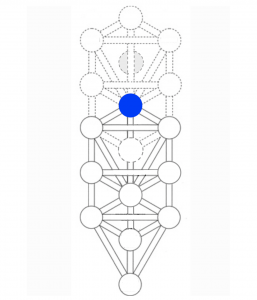
KETHER – THE CROWN
“The First Path is called the Admirable or Hidden Intelligence because it is the Light giving the power of comprehension of the First Principle, which hath no beginning. And it is the Primal Glory, because no created being can attain to its essence.”
Spiritual Experience: Union with God.
The First Principle refers to the “One” as understood by Plotinus, the pervasive transcendence that embraces all, and has no beginning. It is the experience of sunyata which cannot be defined by discursive reasoning. Kether is the Light giving the power of comprehension of this First Principle. And the light appears when we reach a deep level of realization that the self is empty of inherent existence. This brings down all the barriers and takes us to a wondrous world of transcendent bliss and the purity of oneness.
It is the Primal Glory because “no created being can attain to its essence.” This does not mean that Kether cannot be attained, but it does mean that no created being can attain to its essence. When we lose our sense of self, we are no longer an individual created being. This is the logical meaning of the words “no created being can attain to its essence” since it follows from the 11th Path (from Chokmah to Kether), depicted by the Tarot card, Death, that symbolizes the loss of the sense of self, which then has the special dignity of being “able to stand before the Face of the Cause of Causes.”
The interpretation of the Yetziratic text description, here, must then follow the same lines as that for the words of Nagarjuna (from the Mulamadhyamikakarika) which reads:
One who does not grasp onto “I” and “mine,”
That one does not exist.
We must not misinterpret this to mean that it is impossible not to grasp onto “I” or “mine.” What it does means is that it is the realization, that the self is empty of inherent existence, that enables us to not grasp onto “I” or “mine.” In other words, with this realization of emptiness, we know that there is really no inherently-existing one that does not grasp onto “I” or “mine.” That inherently existing self does not exist. Likewise, the words “no created being can attain to its essence” means that we have to lose the sense of self in order to attain to the essence of Kether.
When we lose the sense of self, we have become one with the All, and no longer exist inherently as a created being. The spiritual experience is described as a “union with God,” which is an appropriate term for the fusion of our very being with the All, the “One” that is uncreated and beginningless. However, it does not mean that, at Kether in the World of Assiyah, we have reached the pinnacle of the spiritual quest, because there are many levels of this “union with God.” As we strive higher on Jacob’s Ladder, we can attain more and more profound levels of this unitive state.
The words “no created being can attain to its essence” also refer to what we have discussed earlier in our commentary on the path from Daath to Kether, the path represented by the Tarot card, Temperance. Kether represents that realizational state of mind that we are trying to create in accordance with the mystical experience represented by the revealed Daath. Thus, the words “no created being can attain to its essence” emphasize the fact that we cannot create this state of mind if the sense of a self reappears in our thinking. Even if this sense of the “I” reappears inadvertently, we will be unable to generate the state of mind represented by Kether. As mentioned earlier, when this occurs, we would have to conduct a sort of “witch-hunt” to ferret out, and eliminate, this intruding sense of a self before the realizational state (represented by Kether) can be attained. The fact that this sense of a self invariably prevents the profound and blissful experience of Kether actually serves as a means of verifying that this sense of an “I” is actually a delusion. It is a delusion we are required to eliminate in order to progress higher on the spiritual path.
Kether in the World of Assiyah corresponds with Tiphareth in the World of Yetzirah, and like Tiphareth in Assiyah, it also functions as a Mediating Intelligence. There is another Noble Eightfold Path in the Tree of Life in Yetzirah, and it is centered around Tiphareth in a way that parallels that found in Assiyah. Tiphareth in Yetzirah now functions as the mediating centre for the circuitous paths that again becomes the powerhouse of our spiritual energy that will propel us upwards onto higher and higher levels of the spiritual journey.

We are now into the World of the Limitless because we have unveiled the second of the three Veils of Negative Existence, Ain Sof. The aim of the circuitous paths centered around Tiphareth in Yetzirah and the paths leading upwards to the threshold to the next higher Tree of Life in Briah, are focused on establishing a state of unification with the All, and hence the name Limitless or the All.
It corresponds with our striving to attain the second of the Three Principles of the Path in Tibetan Buddhism, which is the universal altruistic intention to save all sentient beings from suffering. It is the volitional or active expression of the realization of the oneness of all. This is known as bodhicitta, the compassionate wish to attain enlightenment in order to free all sentient beings from suffering. Our motivation and actions thus become one with the unitive state of nonseparation, a state of the realization of the Limitless or the All.